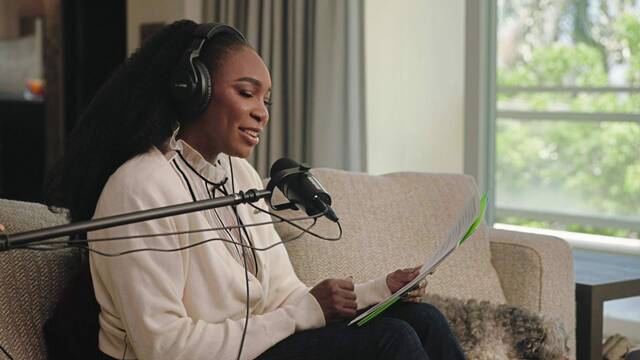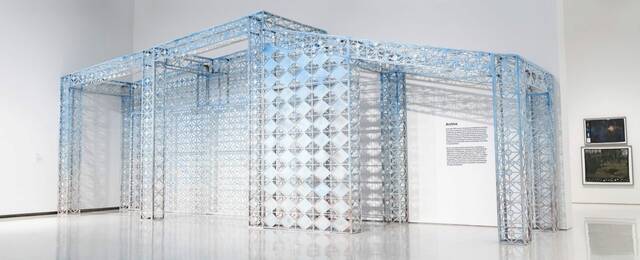Carnegie Museum of Art launches 'Widening the Lens' podcast with Venus Williams
The Carnegie Museum of Art launched its “Widening the Lens” podcast series, featuring tennis champion and emerging contemporary art authority Venus Williams.
The six-episode podcast extends the exhibition “Widening the Lens: Photography, Ecology and the Contemporary Landscape,” which opened on May 12, beyond the gallery walls. The podcast gives permanence to the conversation surrounding photography and the environment, portraying landscapes as more than idyllic, undisturbed vistas devoid of people, said Dan Leers, curator of photography at the Carnegie Museum of Art.
“We want to meet audiences where they are,” Leers said. “The podcast allows us to extend the conversation and invite others who might not otherwise make it to the museum.”
Leers said Williams, the host of the podcast, is deeply engaged with the arts and the exhibition’s themes and is the perfect voice for the podcast.
“Everybody is excited about working with her. She is incredibly generous with her time,” Leers said.
Williams declined to be interviewed for this article, but in an interview with Essence Magazine, she said she was proud to amplify the voices of diverse artists and encourage alternative ways of relating to the landscape around us.
One of those artists is Puerto Rico native Edra Soto, who takes an unconventional approach to photography. Her larger-than-life sculptures greet guests as they enter the exhibition. By leaning into one of the many viewfinders in Soto’s sculpture, guests can peer into her life archive, migration story and view of Puerto Rico.
Soto said there is no division between her life and her art. Her sculpture, now in its third iteration at the Carnegie Museum, was previously displayed at Chicago’s Botanical Gardens.
The viewfinders resemble peepholes, mirroring traditional Puerto Rican architecture and housing all of Soto’s images.
Soto is featured in the exhibition and the sixth episode of the podcast.
“When I think of the images that I take, they have universal qualities,” she said. “They are somewhat recent images from the Puerto Rican landscape presented in the exhibition, and I believe people can identify with them and feel they could come from anywhere in the world.”
Soto finds it compelling how people can engage with her work using their imagination. Her landscapes come from Puerto Rico’s tourism and military colonial sectors, which are part of its historical narrative but not necessarily its present.
“When colonialism is portrayed as part of Puerto Rico’s current cultural identity, I feel it misrepresents what the island really is,” Soto said.
Soto said she hopes people listen to the podcast and connect with the exhibition’s content. She is compulsive about taking photos and hopes to inspire others to examine the world around them.
“I always think of my art as something that has given me a voice,” Soto said.
Leers said the title “Widening the Lens” for both the exhibition and the podcast was no coincidence. He curated the exhibition with Keenan Saiz, Hillman Photography Initiative project curatorial assistant. The exhibition is part of the Hillman Photography Initiative and a series of programs the museum is undertaking, such as “Unsettling Matter,” “Gaining Ground” and “Everlasting Plastics.”
Leers said data shows audiences expect museums to grapple with these complex issues.
“ ‘Widening the Lens’ is about stepping back and considering the communities and individuals impacted by environmental policies and access to the environment that resonate to this day but have not been prominently featured in museums or institutional contexts,” Leers said.
Both the exhibition and the podcast highlight these perspectives from 19 artists. For example, Chanell Stone focuses on displacement resulting from slavery, settler colonial legacies and the Great Migration. She examines the continued disconnect between Black and brown people in California and those in the Deep South. Xaviera Simmons makes photographs of herself holding other newspaper photographs to address how colonial racist legacies have disenfranchised Black and brown communities. She speaks specifically about sundown towns during the Jim Crow era.
Melissa Catanese, a Troy Hill-based photographer, has hundreds of photographs in different sizes and tones lightly affixed to the wall to give the illusion of billowing in the breeze.
“They move back and forth and breathe with the room,” Leers said.
Episode three, “Mythmaking,” features Mark Armijo McKnight, who resituates LGBTQ experiences within the desert landscape of Southern California.
Soto’s work requires viewers to get up close and slow down to examine it, a message echoed by both the exhibition and the podcast. Amid the climate crisis, they hope to create a sense of a horizon looking forward with anticipation of possibility.
“The simplest solution this exhibition proposes is the act of slowing down and close looking,” Leers said.
Editor’s note: An earlier version of this story had an incorrect artist name for episode three of the podcast.
Shaylah Brown is a TribLive reporter covering art, culture and communities of color. A New Jersey native, she joined the Trib in 2023. When she's not working, Shaylah dives into the worlds of art, wellness and the latest romance novels. She can be reached at sbrown@triblive.com.
Remove the ads from your TribLIVE reading experience but still support the journalists who create the content with TribLIVE Ad-Free.



